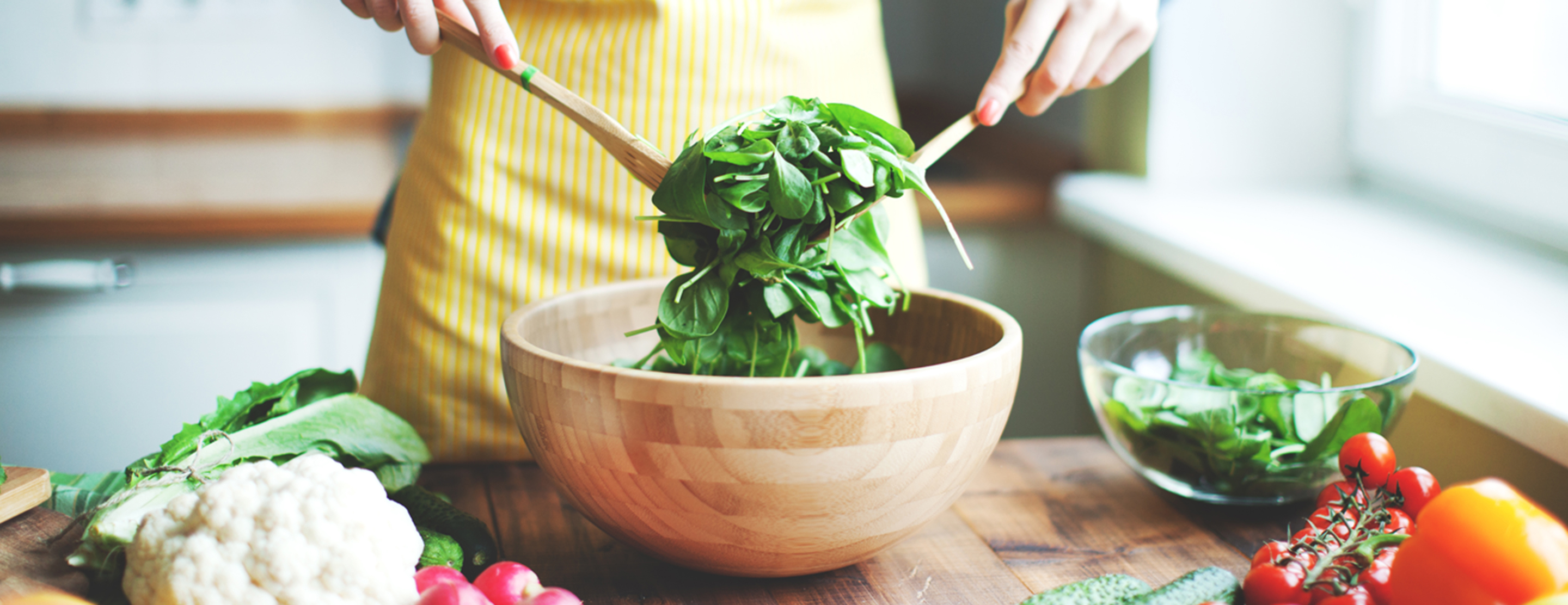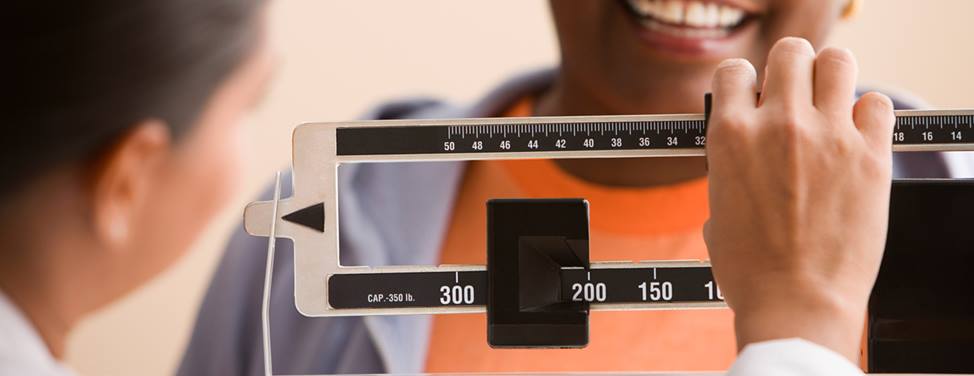
Behavior Modification Ideas for Weight Management
Weight management involves adopting a healthy lifestyle that includes a knowledge of nutrition and exercise, a positive attitude and the right kind of motivation. Internal motives such as better health, increased energy, self-esteem and personal control increase your chances of lifelong weight management success.
Remember to have realistic goals and think long-term success. Believe in yourself and you can do it. The following information will give you ideas to help you meet your goals.
Control Your Home Environment
- Eat only while sitting down at the kitchen or dining room table. Do not eat while watching television, reading, cooking, talking on the phone, standing at the refrigerator or working on the computer.
- Keep tempting foods out of the house — don't buy them.
- Keep tempting foods out of sight. Have low-calorie foods ready to eat.
- Unless you are preparing a meal, stay out of the kitchen.
- Have healthy snacks at your disposal, such as small pieces of fruit, vegetables, canned fruit, pretzels, low-fat string cheese and nonfat cottage cheese.
Control Your Work Environment
- Do not eat at your desk or keep tempting snacks at your desk.
- If you get hungry between meals, plan healthy snacks and bring them with you to work.
- During your breaks, go for a walk instead of eating.
- If you work around food, plan in advance the one item you will eat at mealtime.
- Make it inconvenient to nibble on food by chewing gum, sugarless candy or drinking water or another low-calorie beverage.
- Do not work through meals. Skipping meals slows down metabolism and may result in overeating at the next meal.
- If food is available for special occasions, either pick the healthiest item, nibble on low-fat snacks brought from home, don't have anything offered, choose one option and have a small amount, or have only a beverage.
Control Your Mealtime Environment
- Serve your plate of food at the stove or kitchen counter. Do not put the serving dishes on the table. If you do put dishes on the table, remove them immediately when finished eating.
- Fill half of your plate with vegetables, a quarter with lean protein and a quarter with starch.
- Use smaller plates, bowls and glasses. A smaller portion will look large when it is in a little dish.
- Politely refuse second helpings.
- When fixing your plate, limit portions of food to one scoop/serving or less.
Daily Food Management
- Replace eating with another activity that you will not associate with food.
- Wait 20 minutes before eating something you are craving.
- Drink a large glass of water or diet soda before eating.
- Always have a big glass or bottle of water to drink throughout the day.
- Avoid high-calorie add-ons such as cream with your coffee, butter, mayonnaise and salad dressings.
Shopping
- Do not shop when hungry or tired.
- Shop from a list and avoid buying anything that is not on your list.
- If you must have tempting foods, buy individual-sized packages and try to find a lower-calorie alternative.
- Don't taste test in the store.
- Read food labels. Compare products to help you make the healthiest choices.
Preparation
- Chew a piece of gum while cooking meals.
- Use a quarter teaspoon if you taste test your food.
- Try to only fix what you are going to eat, leaving yourself no chance for seconds.
- If you have prepared more food than you need, portion it into individual containers and freeze or refrigerate immediately.
- Don't snack while cooking meals.
Eating
- Eat slowly. Remember it takes about 20 minutes for your stomach to send a message to your brain that it is full. Don't let fake hunger make you think you need more.
- The ideal way to eat is to take a bite, put your utensil down, take a sip of water, cut your next bite, take a bit, put your utensil down and so on.
- Do not cut your food all at one time. Cut only as needed.
- Take small bites and chew your food well.
- Stop eating for a minute or two at least once during a meal or snack. Take breaks to reflect and have conversation.
Cleanup and Leftovers
- Label leftovers for a specific meal or snack.
- Freeze or refrigerate individual portions of leftovers.
- Do not clean up if you are still hungry.
Eating Out and Social Eating
- Do not arrive hungry. Eat something light before the meal.
- Try to fill up on low-calorie foods, such as vegetables and fruit, and eat smaller portions of the high-calorie foods.
- Eat foods that you like, but choose small portions.
- If you want seconds, wait at least 20 minutes after you have eaten to see if you are actually hungry or if your eyes are bigger than your stomach.
- Limit alcoholic beverages. Try a soda water with a twist of lime.
- Do not skip other meals in the day to save room for the special event.
At Restaurants
- Order à la carte rather than buffet style.
- Order some vegetables or a salad for an appetizer instead of eating bread.
- If you order a high-calorie dish, share it with someone.
- Try an after-dinner mint with your coffee. If you do have dessert, share it with two or more people.
- Don't overeat because you do not want to waste food. Ask for a doggie bag to take extra food home.
- Tell the server to put half of your entree in a to go bag before the meal is served to you.
- Ask for salad dressing, gravy or high-fat sauces on the side. Dip the tip of your fork in the dressing before each bite.
- If bread is served, ask for only one piece. Try it plain without butter or oil. At Italian restaurants where oil and vinegar is served with bread, use only a small amount of oil and a lot of vinegar for dipping.
At a Friend's House
- Offer to bring a dish, appetizer or dessert that is low in calories.
- Serve yourself small portions or tell the host that you only want a small amount.
- Stand or sit away from the snack table. Stay away from the kitchen or stay busy if you are near the food.
- Limit your alcohol intake.
At Buffets and Cafeterias
- Cover most of your plate with lettuce and/or vegetables.
- Use a salad plate instead of a dinner plate.
- After eating, clear away your dishes before having coffee or tea.
Entertaining at Home
- Explore low-fat, low-cholesterol cookbooks.
- Use single-serving foods like chicken breasts or hamburger patties.
- Prepare low-calorie appetizers and desserts.
Holidays
- Keep tempting foods out of sight.
- Decorate the house without using food.
- Have low-calorie beverages and foods on hand for guests.
- Allow yourself one planned treat a day.
- Don't skip meals to save up for the holiday feast. Eat regular, planned meals.
Exercise Well
- Make exercise a priority and a planned activity in the day.
- If possible, walk the entire or part of the distance to work.
- Get an exercise buddy. Go for a walk with a colleague during one of your breaks, go to the gym, run or take a walk with a friend, walk in the mall with a shopping companion.
- Park at the end of the parking lot and walk to the store or office entrance.
- Always take the stairs all of the way or at least part of the way to your floor.
- If you have a desk job, walk around the office frequently.
- Do leg lifts while sitting at your desk.
- Do something outside on the weekends like going for a hike or a bike ride.
Have a Healthy Attitude
- Make health your weight management priority.
- Be realistic. Have a goal to achieve a healthier you, not necessarily the lowest weight or ideal weight based on calculations or tables.
- Focus on a healthy eating style, not on dieting. Dieting usually lasts for a short amount of time and rarely produces long-term success.
- Think long term. You are developing new healthy behaviors to follow next month, in a year and in a decade.
UCSF Health medical specialists have reviewed this information. It is for educational purposes only and is not intended to replace the advice of your doctor or other health care provider. We encourage you to discuss any questions or concerns you may have with your provider.









